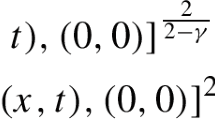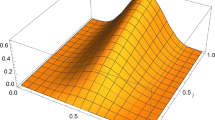A new approach to the construction of constitutive integral relations, involving the introduction into consideration of local functions for a heat flow or a temperature determined directly from the differential heat-conduction equation, is proposed. With the use of this approach, new integral relations: the temperature-momentum integral of single modification, the temperature-momentum integral of double modification, the heat-flow integral, and the temperature-function integral, have been obtained. On the basis of these integrals as well as the integral method of heat balance and the refined integral method, different variants of the hybrid integral method realized with the use of manifold integral relations were investigated. In addition to the Langford norm, new error norms were introduced into consideration. The parabolic solutions obtained possess much better qualities compared to those of the analogous known solutions.
Similar content being viewed by others
References
T. R. Goodman, Application of integral methods to transient nonlinear heat transfer, Adv. Heat Transf., Academic Press, New York (1964), Vol. 1, pp. 51–122.
A. S. Wood, A new look at the heat balance integral method, Appl. Math. Model., 25, No. 10, 815–824 (2001).
W. Braga and M. Mantelli, A new approach for the heat balance integral method applied to heat conduction problems, Proc. 38th AIAA Thermophys. Conf., Toronto, Ontario, Canada, Paper AIAA-2005-4686.
D. Langford, The heat balance integral method, Int. J. Heat Mass Transf., 16, No. 12, 2424–2428 (1973).
V. A. Kot, Method of boundary characteristics, J. Eng. Phys. Thermophys., 88, No. 6, 1390–1408 (2015).
H. S. Carslow and J. C. Jaeger, Conduction of Heat in Solids, 2nd edn., Oxford University Press, Oxford, UK (1992).
V. N. Volkov, A refinement of the Karman–Pohlhausen integral method in boundary layer theory, J. Eng. Phys. Thermophys., 9, No. 5, 371–374 (1965).
V. N. Volkov and V. K. Li-Orlov, A refinement of the integral method in solving the heat conduction equation, Heat Transf. Sov. Res., 2, No. 2, 41–47 (1970).
N. Sadoun, E. K. Si-Ahmed, and P. Colinet, On the refined integral method for the one-phase Stefan problem with time-dependent boundary conditions, Appl. Math. Model., 30, No. 6, 531–544 (2006).
N. Sadoun, E. K. Si-Ahmed, P. Colinet, and J. Legrand, On the Goodman heat-balance integral method for Stefan likeproblems: further considerations and refinements, Therm. Sci., 13, No. 2, 81–96 (2009).
R. S. Gupta and N. C. Banik, Constrained integral method for solving moving boundary problems, Comput. Methods Appl. Mech. Eng., 67, No. 2, 211–221 (1988).
R. S. Gupta and N. C. Banik, Diffusion of oxygen in a sphere with simultaneous absorption, Appl. Math. Model., 14, No. 3, 114–121 (1990).
J. Hristov, The heat-balance integral method by a parabolic profile with unspecified exponent: Analysis and exercises, Therm. Sci., 13, No. 2, 27–48 (2009).
A. Bejan, Second law analysis in heat transfer and thermal design, Advances in Heat Transfer, Academic Press, New York (1982), Vol. 1, pp. 1–58.
Z. Kolenda, J. Donizak, and J. Hubert, On the minimum entropy production in steady-state heat conduction processes, Energy, 29, Nos. 12–13, 2441–2460 (2004).
J. Hristov, Research note on a parabolic heat-balance integral method with unspecified exponent, Therm. Sci., 13, No. 2, 49–59 (2009).
J. A. Esfahani and S. Koohi-Fayegh, Entropy generation analysis in error estimation an approximate solution a constant surface temperature semi-infinite conductive problem, Therm. Sci., 13, No. 2, 133–140 (2009).
T. G. Myers, Optimizing the exponent in the heat balance and refined integral methods, Int. Commun. Heat Mass Transf., 36, No. 2, 143–147 (2009).
J. Hristov, The heat-balance integral: 1. How to calibrate the parabolic profile? C. R. Acad. Sci. Mec., 340, No. 7, 485–492 (2012).
J. Hristov, The heat-balance integral: 2. Parabolic profile with a variable exponent: The concept, analysis and numerical experiments, C. R. Acad. Sci. Mec., 340, No. 7, 493–500 (2012).
S. L. Mitchell and T. G. Myers, Improving the accuracy of heat balance integral methods applied to thermal problems with time dependent boundary conditions, Int. J. Heat Mass Transf., 53, No. 17, 3540–3551 (2010).
T. F. Zien, Approximate calculation of transient heat conduction, AIAA J., 14, No. 3, 401–406 (1976).
T. F. Zien, Integral solution of ablation problems with time-dependent heat flux, AIAA J., 16, No. 12, 1287–1295 (1978).
Author information
Authors and Affiliations
Corresponding author
Additional information
Translated from Inzhenerno-Fizicheskii Zhurnal, Vol. 91, No. 6, pp. 1463–1484, November–December, 2018.
Rights and permissions
About this article
Cite this article
Kot, V.A. Parabolic Profile in Heat-Conduction Problems. 1. Semi-Bounded Space with a Surface of Constant Temperature. J Eng Phys Thermophy 91, 1391–1412 (2018). https://doi.org/10.1007/s10891-018-1873-1
Received:
Published:
Issue Date:
DOI: https://doi.org/10.1007/s10891-018-1873-1




